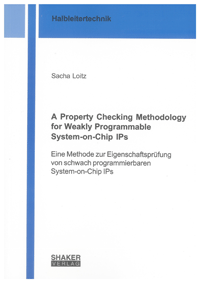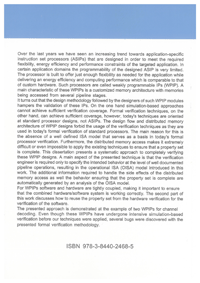
Shop : Details
Shop
Details
45,80 €ISBN 978-3-8440-2468-5Softcover152 pages39 figures224 g21 x 14,8 cmEnglishThesis
January 2014
Sacha Loitz
A Property Checking Methodology for Weakly Programmable System-on-Chip IPs
Eine Methode zur Eigenschaftsprüfung von schwach programmierbaren System-on-Chip IPs
Over the last years we have seen an increasing trend towards application speci?c instruction
set processors that are designed in order to meet the required ?exibility, energy ef?ciency
and performance constraints. In its extreme extend these processors are that
specialized that they only offer a limited programmability meeting exactly the demands
of the targeted application domain. Such processors are called weakly programmable
system-on-chip IPs (WPIP). The focus of these WPIPs is to offer just as much ?exibility
as required while delivering energy ef?ciency and performance comparable to that of custom
hardware. A main characteristic of these WPIPs is a customized memory architecture
with memories being accessed from several pipeline stages.
It turns out that the design ?ow followed by the designers of such WPIP designs hampers the validation of these IPs. On the one hand simulation based approaches can not achieve a suf?cient coverage. Formal veri?cation techniques, on the other hand, can achieve a suf?cient coverage, however, the design ?ow and distributed memory architecture forbid the usage of the veri?cation techniques as they are used in today’s formal veri?cation of standard processors.
This dissertation presents a systematic approach to completely verify these WPIP designs. A main aspect of the presented technique is that the veri?cation engineer is only required to specify the intended behavior at the level of well documented pipeline operations resulting in the operational ISA (OISA) model introduced in this work. The additional information required to handle the side-effects of the distributed memory access as well the behavior ensuring that the property set is complete are automatically generated by an analysis of the OISA model.
For WPIPs software and hardware are tightly coupled together making it important to ensure that the combined hardware software system is working correctly. The second part of this work presents how to reuse the property set from the hardware veri?cation for the veri?cation of the software.
The presented approach is demonstrated at the example of two WPIPs for channel decoding. Even so these WPIPs were intensively simulated beforehand several bugs were discovered with the presented formal veri?cation methodology.
It turns out that the design ?ow followed by the designers of such WPIP designs hampers the validation of these IPs. On the one hand simulation based approaches can not achieve a suf?cient coverage. Formal veri?cation techniques, on the other hand, can achieve a suf?cient coverage, however, the design ?ow and distributed memory architecture forbid the usage of the veri?cation techniques as they are used in today’s formal veri?cation of standard processors.
This dissertation presents a systematic approach to completely verify these WPIP designs. A main aspect of the presented technique is that the veri?cation engineer is only required to specify the intended behavior at the level of well documented pipeline operations resulting in the operational ISA (OISA) model introduced in this work. The additional information required to handle the side-effects of the distributed memory access as well the behavior ensuring that the property set is complete are automatically generated by an analysis of the OISA model.
For WPIPs software and hardware are tightly coupled together making it important to ensure that the combined hardware software system is working correctly. The second part of this work presents how to reuse the property set from the hardware veri?cation for the veri?cation of the software.
The presented approach is demonstrated at the example of two WPIPs for channel decoding. Even so these WPIPs were intensively simulated beforehand several bugs were discovered with the presented formal veri?cation methodology.
Keywords: formal verification; application specific instruction set processors; completeness; Formale Verifikation; Anwendungsspezifische Prozessoren; Vollständigkeit; hardware verification; software verification; Hardware Verifikation; Software Verifikation
Available online documents for this title
You need Adobe Reader, to view these files. Here you will find a little help and information for downloading the PDF files.
Please note that the online documents cannot be printed or edited.
Please also see further information at: Help and Information.
Please also see further information at: Help and Information.
| Document |  | Abstract | ||
| Type |  | |||
| Costs |  | free | ||
| Action |  | Download the file | ||
| Document |  | Document | ||
| Type |  | |||
| Costs |  | 34,35 € | ||
| Action |  | Purchase in obligation and download the file | ||
| Document |  | Table of contents | ||
| Type |  | |||
| Costs |  | free | ||
| Action |  | Download the file | ||
User settings for registered online customers (online documents)
You can change your address details here and access documents you have already ordered.
User
Not logged in
Export of bibliographic data
Shaker Verlag GmbH
Am Langen Graben 15a
52353 Düren
Germany
Am Langen Graben 15a
52353 Düren
Germany
Mon. - Thurs. 8:00 a.m. to 4:00 p.m.
Fri. 8:00 a.m. to 3:00 p.m.
Fri. 8:00 a.m. to 3:00 p.m.
Contact us. We will be happy to help you.



